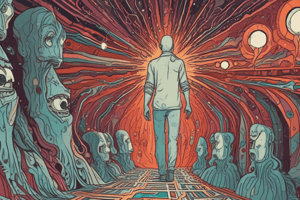Podcast
Questions and Answers
Which of the following is an example of a positive symptom of schizophrenia?
Which of the following is an example of a positive symptom of schizophrenia?
- Diminished emotional expression
- Unchanging and unresponsive facial expression
- Avoidance of eye contact
- Belief in supernatural forces (correct)
What is an example of a negative symptom of schizophrenia?
What is an example of a negative symptom of schizophrenia?
- Belief in supernatural forces
- Hearing imaginary voices
- Reacting with inappropriate emotional response
- Talking in rhymes (correct)
Which symptom of schizophrenia involves reacting with an inappropriate emotional response to positive or negative events?
Which symptom of schizophrenia involves reacting with an inappropriate emotional response to positive or negative events?
- Inappropriate affect (correct)
- Delusions of grandeur
- Disorganized speech of thought
- Hallucinations
What represents an excess of typical function in schizophrenia?
What represents an excess of typical function in schizophrenia?
Which symptom of schizophrenia involves peculiar associations among ideas?
Which symptom of schizophrenia involves peculiar associations among ideas?
What is an example of diminished emotional expression in schizophrenia?
What is an example of diminished emotional expression in schizophrenia?
What is the primary difference between deep brain stimulation and repetitive Transcranial Magnetic Stimulation (rTMS)?
What is the primary difference between deep brain stimulation and repetitive Transcranial Magnetic Stimulation (rTMS)?
What is the role of the anterior cingulate gyrus in the brain?
What is the role of the anterior cingulate gyrus in the brain?
What is a potential risk associated with Deep Brain Stimulation?
What is a potential risk associated with Deep Brain Stimulation?
What is the main reason why brain stimulation works to treat depression?
What is the main reason why brain stimulation works to treat depression?
What is the Monoamine Theory of depression primarily based on?
What is the Monoamine Theory of depression primarily based on?
What is a challenge of the Monoamine Theory of depression?
What is a challenge of the Monoamine Theory of depression?
Which factor is not considered a leading cause of schizophrenia according to the text?
Which factor is not considered a leading cause of schizophrenia according to the text?
What is the focus of the neurodevelopmental theory of schizophrenia?
What is the focus of the neurodevelopmental theory of schizophrenia?
What is the potential use of functional connectivity changes in schizophrenia research?
What is the potential use of functional connectivity changes in schizophrenia research?
What is the focus of the study of schizophrenia-related genes?
What is the focus of the study of schizophrenia-related genes?
What led to the restriction of psychedelic research in humans in the 1970s?
What led to the restriction of psychedelic research in humans in the 1970s?
What is the role of the mesocorticolimbic dopamine pathway in schizophrenia?
What is the role of the mesocorticolimbic dopamine pathway in schizophrenia?
Which class of antidepressants inhibits the activity of monoamine oxidase?
Which class of antidepressants inhibits the activity of monoamine oxidase?
What percentage of clinically depressed patients show improvement with antidepressants?
What percentage of clinically depressed patients show improvement with antidepressants?
Which antidepressant drug was developed for tuberculosis and marketed in 1957?
Which antidepressant drug was developed for tuberculosis and marketed in 1957?
Which gender is twice as likely to be diagnosed with depression, especially during adolescence?
Which gender is twice as likely to be diagnosed with depression, especially during adolescence?
Which type of brain stimulation has been used to treat depression when other treatments are ineffective?
Which type of brain stimulation has been used to treat depression when other treatments are ineffective?
Which group has a higher likelihood of suffering chronic and debilitating cases of depression?
Which group has a higher likelihood of suffering chronic and debilitating cases of depression?
Which of the following best describes avolition?
Which of the following best describes avolition?
What marked the first major breakthrough in antipsychotic drugs?
What marked the first major breakthrough in antipsychotic drugs?
What is the primary effect of atypical antipsychotics like clozapine?
What is the primary effect of atypical antipsychotics like clozapine?
What is the dopamine hypothesis regarding schizophrenia symptoms?
What is the dopamine hypothesis regarding schizophrenia symptoms?
Why is reserpine no longer used in treating schizophrenia?
Why is reserpine no longer used in treating schizophrenia?
What is catatonia in individuals with schizophrenia?
What is catatonia in individuals with schizophrenia?
Flashcards are hidden until you start studying
Study Notes
Understanding Schizophrenia and Antipsychotic Drugs
- Avolition refers to a reduction or absence of motivation, hindering the ability to start or finish tasks.
- Catatonia involves remaining motionless in awkward positions for extended periods, often seen in individuals with schizophrenia.
- Diagnosis of schizophrenia spectrum disorder requires the recurrence of any two symptoms for over a month, with one being delusions, hallucinations, or disorganized thought.
- Antipsychotic drugs are used to treat schizophrenia and other psychotic symptoms in various disorders, aiding in the reduction of psychosis.
- The accidental discovery of chlorpromazine in the 1950s marked the first major breakthrough in antipsychotic drugs.
- Chlorpromazine alleviates symptoms of schizophrenia, calming agitated patients and activating emotionally blunted ones.
- Reserpine, derived from the Indian snake root plant, was initially used to treat schizophrenia but is no longer in use due to its adverse effects on blood pressure.
- The dopamine hypothesis suggests that an imbalance in dopamine levels contributes to symptoms of schizophrenia, including delusions and hallucinations.
- Antipsychotic drugs affect dopamine levels and have a high affinity for dopamine receptors, particularly the D2 receptor.
- Atypical antipsychotics, such as clozapine, are effective against schizophrenia without binding strongly to D2 receptors.
- Research on hallucinogenic drugs focuses on their effects in modeling schizophrenia symptoms and their potential use in treating psychiatric disorders.
- The two lines of study for psychedelic drugs involve modeling schizophrenia symptoms and exploring their potential for treating psychiatric disorders.
Studying That Suits You
Use AI to generate personalized quizzes and flashcards to suit your learning preferences.




